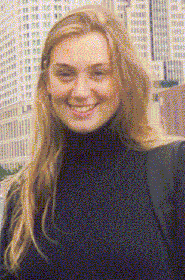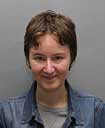Laura EDERA
Universita' degli Studi di Milano -
laura.edera@mi.infn.it

I am working in the Charm Photoproduction experiment FOCUS at Fermilab. I started my collaboration with FOCUS during my degree in Physics and I am now continuing my activity for Ph.D. In particular, I am working on the Dalitz plot analysis of Charm Meson decays. Dalitz plot analysis provides unique information about the dynamics of the decay and the role of final state interactions. The very high statistics available in FOCUS allows for investigations of rare and suppressed decays. I am studying the double and he single Cabibbo suppressed channels D+ -> K+ pi- pi+ ( ~ 200 events) and Ds+ -> K+ pi- pi+ (~ 600 events). The measurements of decay fractions and relative phases, extracted from the amplitude analysis of these rare modes, are important to complete the Charm experimental scenario.
Elisa FALCHINI
University of Siena
elisa.falchini@pi.infn.it

For my Ph.D. thesis I am working on AMS-02, a cosmic ray experiment which will be installed on the International Space Station in 2005. AMS-02 has been thought to measure the Antimatter abundance and study the Dark Matter nature. During the last two years, I have developed a Monte Carlo study of the AMS rejection power between protons and positrons; this feature will be essential to recognise the Neutralino annichilation products. Recently I have performed analysis of the data collected in two different Test Beam, studying the performance of the electromagnetic calorimeter of AMS. Now I am working on a possible implementation of an calorimeter stand alone trigger for gamma.
Sinead FARRINGTON
Glasgow University
sineadf@fnal.gov

I am a Glasgow PhD student on the CDF experiment at Fermilab. During my first year as a PhD student I helped to test, install and cable the Silicon Vertex detector and was involved in its commissioning at the commencement of CDF Run II. This required working in a team of experts identifying and solving problems in the silicon detector. I developed monitoring techniques and test code to identify troublesome components and to validate the silicon detector data taking; this is an ongoing committment. In run II, CDF has included a new trigger designed to identify B semileptonic decays through the presence of a lepton incoincidence with a displaced vertex. I have been analysing this sample: in particular reconstructing D mesons and lepton tracks so as to test the trigger's efficacy. Ihave cleanly identified the D0 (-> K-pi+) and have isolated the D+ (-> K-pi+pi+) in data. Adapting these methods to the reconstruction of a lepton and D+_s meson ( -> K-K+pi-) should lead me to a measurement of the B0_s lifetime via the spatial distribution of the displaced vertices.
James FERRANDO
Oxford University
ferrando@mail.desy.de

For my D.Phil Thesis I am working on ZEUS, one of the two hadron-electron colliding beam experiments located on HERA at DESY. To this end I have worked extensively on the hardware for an optical alignment system for the new ZEUS microvertex detector for the current HERA/ZEUS upgrade.At the same time I am part of a small expert team for the CTD, the key tracking component of ZEUS, performing regular maintenance on it. In Physics I am working on a measurement of the cross section for single W production at HERA using the decay hadronic channel.
Paraskevi GANOTI
University of Athens
pganoti@cc.uoa.gr

Stephen GIBSON
Oxford University
s.gibson1@physics.ox.ac.uk

Iwona GRABOWSKA-BOLD
University of Mining and Metallurgy Cracow
grabowsk@chall.ifj.edu.pl
